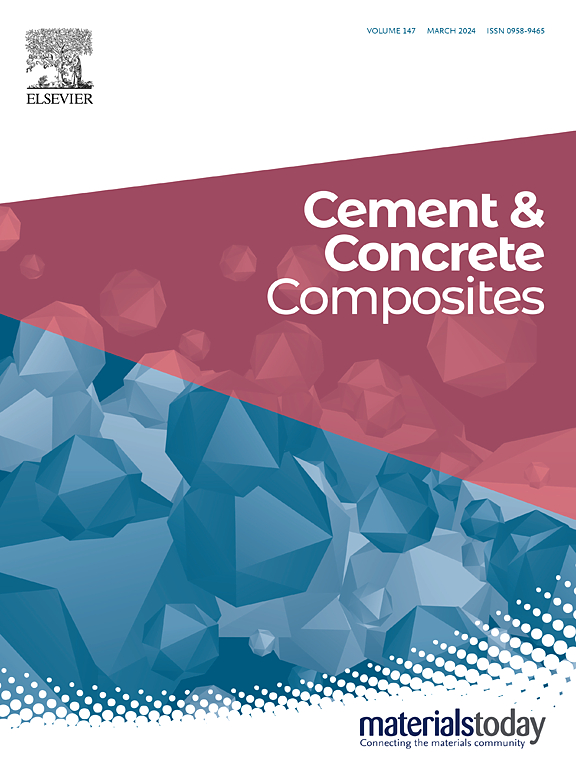半湿型CO2矿化改性硅灰石:在高早强水泥中的应用及与常用补充胶凝材料的对比分析
IF 13.1
1区 工程技术
Q1 CONSTRUCTION & BUILDING TECHNOLOGY
引用次数: 0
摘要
矿物碳酸化技术被广泛认为是减缓全球变暖的有效途径。本研究提出了半湿式CO2矿化改性硅灰石(WS)的方法,成功合成了一种富含碳酸盐和无定形SiO2的反应性胶凝材料碳酸化硅灰石(CWS)。这种创新的方法不仅使水煤浆具有显著的火山灰活性,而且能够有效地固存二氧化碳。本研究系统概述了水煤浆的制备过程,并探讨了其对高早强水泥(HEC)体系水化特性、微观结构演变和性能发展的影响。并与矿渣和粉煤灰进行了对比分析。本研究结果显示,CWS在早期表现出轻微的水化抑制作用,随着时间的推移逐渐减弱。28天后,水煤浆体系的强度超过了纯HEC,电阻率提高了79.3%,明显超过了渣体系24.1%的提高幅度。水煤浆不仅具有火山灰活性,而且与铝相具有协同作用。其消耗氢氧化钙和产生水化产物的能力超过了矿渣和粉煤灰,有效地将总孔隙体积减小到与纯HEC体系相当的水平。此外,独特的水煤浆制备工艺显示出良好的CO2固存潜力(285.5 g CO2/kg)。这种方法不仅提供了一种有效的解决方案,以缓解目前scm的短缺,而且为建筑行业提供了一种可持续的方法,将高性能与低碳排放相结合。本文章由计算机程序翻译,如有差异,请以英文原文为准。
Semi-wet CO2 mineralized modified wollastonite: Application in high-early strength cement and comparative analysis with common supplementary cementitious materials
Mineral carbonation technology is widely recognized as an effective approach for mitigating global warming. This study proposes a semi-wet CO2 mineralization method to modify wollastonite (WS) and successfully synthesizes a reactive cementitious material—carbonated wollastonite (CWS)—that is rich in carbonate and amorphous SiO2. This innovative method not only imparts significant pozzolanic activity to the CWS but also enables efficient CO2 sequestration. This study systematically outlines the CWS preparation process and investigates its influence on the hydration characteristics, microstructural evolution, and performance development of a high-early strength cement (HEC) system. Additionally, a comparative analysis with slag and fly ash is conducted. The results of this study revealed that CWS exhibited a slight hydration inhibition effect in the early stage, which gradually diminished over time. After 28 days, the strength of the CWS system surpassed that of pure HEC, and its resistivity increased by 79.3 %, significantly exceeding the 24.1 % improvement observed in the slag system. CWS not only exhibits pozzolanic activity but also interacts synergistically with the aluminum phase. Its ability to consume calcium hydroxide and generate hydration products surpasses that of slag and fly ash, effectively reducing the total pore volume to a level comparable to that of the pure HEC system. In addition, the unique preparation process of CWS shows an excellent CO2 sequestration potential of 285.5 g CO2/kg. This method not only offers an effective solution to mitigate the current shortage of SCMs but also provides a sustainable approach for the construction industry, combining high performance with low carbon emissions.
求助全文
通过发布文献求助,成功后即可免费获取论文全文。
去求助
来源期刊

Cement & concrete composites
工程技术-材料科学:复合
CiteScore
18.70
自引率
11.40%
发文量
459
审稿时长
65 days
期刊介绍:
Cement & concrete composites focuses on advancements in cement-concrete composite technology and the production, use, and performance of cement-based construction materials. It covers a wide range of materials, including fiber-reinforced composites, polymer composites, ferrocement, and those incorporating special aggregates or waste materials. Major themes include microstructure, material properties, testing, durability, mechanics, modeling, design, fabrication, and practical applications. The journal welcomes papers on structural behavior, field studies, repair and maintenance, serviceability, and sustainability. It aims to enhance understanding, provide a platform for unconventional materials, promote low-cost energy-saving materials, and bridge the gap between materials science, engineering, and construction. Special issues on emerging topics are also published to encourage collaboration between materials scientists, engineers, designers, and fabricators.
 求助内容:
求助内容: 应助结果提醒方式:
应助结果提醒方式:


